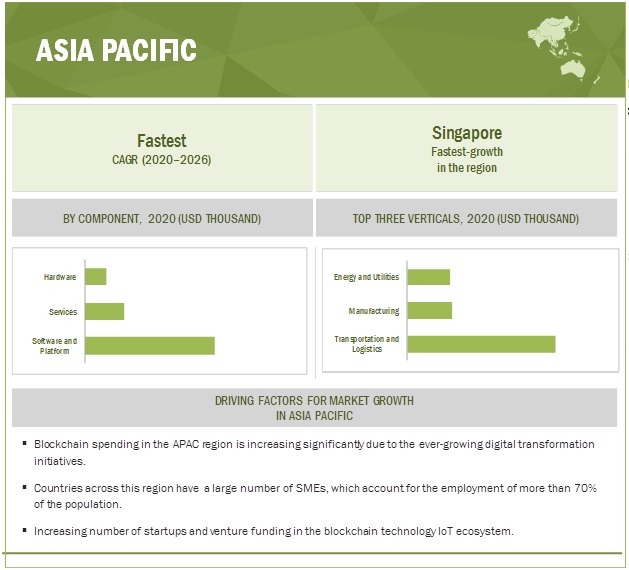< Key Hightlight >
The global blockchain IoT market size is projected to grow from USD 258 million in 2020 to USD 2,409 million by 2026, at a Compound Annual Growth Rate (CAGR) of 45.1% during the forecast period. The growing need for IoT security, simplified processes supported with transparency and immutability, and high adoption of blockchain-based IoT solutions using smart contracts and AI is expected to surge demand for blockchain IoT market globally.

To know about the assumptions considered for the study, Request for Free Sample Report
COVID-19 Impact Analysis on Blockchain IoT Market
The COVID-19 pandemic has affected every segment of society, including individuals and businesses. The internet ecosystem has been playing a pivotal role all over the globe. Due to the COVID-19 pandemic, the dependency on online businesses has increased significantly. BFSI, healthcare and life sciences, manufacturing, automotive, retail, transport and logistics, among others, are leveraging the internet to provide necessary services to consumers. Vendors have experienced decreased demand for a blockchain IoT system. The lockdown implemented around the world had affected the demand and supply of the various hardware components required for blockchain IoT. The healthcare and government verticals are set to witness a moderate adoption globally to protect hospitals, government buildings, and civilians during pandemics and disasters in the near future using IoT sensors and blockchain.
Market Dynamics
Driver: Growing need for IoT security
The widespread use of IoT devices is observed in several applications, such as smart city projects, smart transportation, vehicular connectivity, smart grids, and smart homes. However, with increased connectivity, IoT devices are massively becoming victims of security vulnerabilities, such as Distributed Denial of Service (DDoS) attacks, botnet attacks, and insecure ecosystem interfaces. Unsecure IoT devices provide easy access for cybercriminals to exploit the security systems. Blockchain solutions create a decentralized network of IoT devices, which eliminates the need for a central location to handle device communication. Blockchain offers an intriguing solution for IoT security powered by strong protection against data tampering and illegal access to IoT devices. Leveraging blockchain to store IoT data ensures an added layer of security, robust encryption, and transparency so that only the authorized individual is enabled access to the IoT network. Hence, enterprises that use IoT-enabled sensors are increasingly relying on blockchain technology to enhance the security of their IoT assets.
Restraint: Scalability, processing power, and storage issues
The IoT ecosystems are very diverse. The designing of IoT devices in alignment with blockchain technology poses several difficulties. One of the major hurdles faced by IoT is scalability, which includes handling a massive volume of data collected by a large network of sensors. Moreover, the processing power and time required to perform encryption of all IoT devices in a blockchain-based ecosystem are not as desired. Storage is another major issue in blockchain systems that store the ledger on edge nodes. IoT smart devices at the edge are still not capable of storing huge volumes of data or handling high computational power. Blockchain and IoT are both emerging technologies that possess great benefits. However, they still lack widespread adoption due to the aforementioned technical and security concerns.
Opportunity: Higher adoption of blockchain-based IoT solutions using smart contracts and AI
Smart contracts are the next-enabling technology for novel IoT applications. A smart contract is another key application area, which is the central component of the next-generation blockchain platforms. Ethereum, a public blockchain platform, is currently the most advanced smart contract-enabled blockchain. Smart contracts are terms and conditions that parties can specify to ensure trust and provide visibility in the enforceability of a contract. Blockchain-IoT provides numerous benefits when combined with smart contract technology. For example, Biz4Intellia’s Intellia IoT smart contract solution, uses one of the best combinations of blockchain and IoT with customized smart contracts; the smart contracts eliminate the manipulation of contracts, the sensors mounted on goods monitor information in real time as mentioned in smart contracts, and parties are immediately notified in case of breaches.
Challenge: Lack of awareness related to blockchain-IoT technology
The major limitation to the growth of the blockchain IoT market is the lack of awareness about distributed ledger technology, integration of blockchain with IoT, and its application in various sectors. End-users in various verticals lack an understanding of the benefits of this disruptive technology and how it works with IoT. This could restrain companies from investing in this evolving technology, which is still decentralized and lacks regulatory status. In its current form, blockchain technology is something of a vast, unknown frontier with uncertain growth. Investors, the public, and entrepreneurs are yet to leverage its potential for transforming business processes.
Based on vertical, the building management vertical to grow at the highest CAGR during the forecast period
The building management segment is expected to increasingly adopting blockchain IoT solutions. With the help of blockchain, smart home devices become immutable and safe from cyberattacks. Blockchain also enables building owners to securely enable other parties to access specific areas and devices without giving them access to everything. Increasing marketplace efficiency is advantageous in facility management too. The blockchain is a secure way to automate transactions and transfer data. It has changed the way buildings are being operated. By using the blockchain in automation, it provides facility management services, equipment warranties, indoor occupancy tracking, and track of spaces available. Therefore, the building management segment registers the highest growth rate during the forecast period.

To know about the assumptions considered for the study, download the pdf brochure
APAC to account for the highest CAGR during the forecast period
Asia Pacific (APAC) has witnessed an advanced and dynamic adoption of new technologies and is expected to record the highest CAGR in the global Blockchain IoT market during the forecast period. The Blockchain IoT market in Asia Pacific (APAC) is projected to grow at the highest CAGR during the forecast period. APAC countries are increasingly investing in blockchain IoT projects. The region comprises emerging economies, such as ANZ, China, Japan, and Singapore. With the proliferation of IoT in the APAC region, security and fraud concerns have risen; the integration of blockchain with IoT would enhance enterprise databases' trust and security. Enterprises in the APAC region are embracing blockchain technologies. Companies operating in APAC would benefit from the flexible economic conditions, industrialization-motivated policies, political transformation, and the growing digitalization, which is expected to have a significant impact on the business community and drive the blockchain IoT market growth.
This research study outlines the market potential, market dynamics, and key and innovative vendors in the Blockchain IoT market include IBM (US), Microsoft (US), Intel (US), Amazon Web Services (US), Huawei (China), Cisco (US), SAP (Germany), Ethereum Foundation (Switzerland), The Linux Foundation (US), R3 (US), Arctouch (US), Waltonchain (China), Helium (US), Factom (US), HYPR (US), Chronicled (US), KrypC (India), IoTeX (Singapore), Discovery (Malta), Iota (Germany), Atonomi (US), Xage (US), Ambrosus (Estonia), NetObjex (US), and Grid+ (US).
The study includes an in-depth competitive analysis of these key players in the Blockchain IoT market with their company profiles, recent developments, and key market strategies.
Scope of the Report
Report Metrics | Details |
Market size available for years | 2018–2026 |
Base year considered | 2019 |
Forecast period | 2020–2026 |
Forecast units | Value (USD) |
Segments covered | Component, Application, Organization Size, Vertical, and Regions. |
Geographies covered | North America, Europe, APAC, Middle East and Africa (MEA), and Latin America. |
Major companies covered | IBM (US), Microsoft (US), Intel (US), Amazon Web Services (US), Huawei (China), Cisco (US), SAP (Germany), Ethereum Foundation (Switzerland), The Linux Foundation (US), R3 (US), Arctouch (US), Waltonchain (China), Helium (US), Factom (US), HYPR (US), Chronicled (US), KrypC (India), IoTeX (Singapore), Discovery (Malta), Iota (Germany), Atonomi (US), Xage (US), Ambrosus (Estonia), NetObjex (US), and Grid+ (US). |
This research report categorizes the Blockchain IoT to forecast revenues and analyze trends in each of the following submarkets:
Based on the component:
- Hardware
- IoT Sensors
- Motion Sensors
- GPS
- Temperature Sensors
- Vehicle Information
- Connected Devices
- Crypto-wallets
- Software and Platform
- Services
- Technology Advisory and Consulting Services
- Deployment and Integration Services
- Support and Maintenance
Based on applications:
- Smart Contracts
- Security
- Data Sharing/ Communication
- Asset Tracking and Management
- Other applications* (real-time workforce tracking and workforce management)
Based on organization size:
Based on the vertical:
- Energy and Utilities
- Transportation and Logistics
- Manufacturing
- Building Management
- Healthcare
- Retail
- Wearable and Mobile Devices
- Smart City
- Other verticals** (food and beverages, pharmaceutical, mining, agriculture, construction, and real estate)
Based on the region:
- North America
- Europe
- United Kingdom (UK)
- Germany
- France
- Rest of Europe (EU and Non-EU countries)
- APAC
- China
- Japan
- Singapore
- Rest of APAC (India, the Philippines, Vietnam, Indonesia, Taiwan, and South Korea)
- Middle East and Africa (MEA)
- Latin America
- Brazil
- Mexico
- Rest of Latin America (Chile, Argentina, Colombia, and Peru)
Recent Developments:
- In January 2021, IBM collaborated with Thai Reinsurance Public Company Limited (Thai Re) to launch the Insurer Network, a reinsurance smart contract platform using IBM blockchain technology on IBM Cloud. The IBM Blockchain technology built on the highly secured IBM Cloud will enable Thai Re to gain efficiency and speed in processing reinsurance contracts with a secure single version of truth documentation.
- In June 2020, Intel signed a Memorandum of Understanding (MoU) with the ADDA. It is aimed at accelerating digital transformation in Abu Dhabi by leveraging Intel’s Innovation Centre in Dubai and Intel’s expertise in the field of AI, video analytics, edge computing, blockchain, IoT, workplace transformation, and Augmented Reality (AR). The MoU also supports the Abu Dhabi Vision 2030.
- In September 2020, Huawei updated its blockchain-based cloud service, Blockchain Service 2.0 (BCS 2.0). The new and enhanced platform meets performance requirements of 50,000 Transactions Per Second (TPS), which is much higher than Bitcoin and Ethereum. Furthermore, BCS 2.0 extension capacity will reach more than 1,000 nodes, thereby meeting the requirements of commercial and large-scale blockchain networks.
- In October 2020, R3 partnered with Mphasis. The motive of this partnership was to develop a blockchain-based payment and financing solution for global supply chains. R3's blockchain platform, Corda, is used by Mphasis to extend its Payments and Trade Finance technology solutions portfolio.
- In December 2020, AWS teamed up with BMW Group to accelerate data innovation in the automotive industry. The BMW Group’s PartChain Platform leveraged AWS services, such as Amazon Elastic Kubernetes Service (Amazon EKS), in line with the open-source blockchain management tools to trace automotive parts and raw materials throughout the automotive supply chain.
Key Benefits of Buying the Report
The report would provide the market leaders/new entrants in this market with information on the closest approximations of the revenue numbers for the overall blockchain IoT market and its sub-segments. It would help stakeholders understand the competitive landscape and gain more insights to position their business and plan suitable go-to-market strategies. It also helps stakeholders understand the market's pulse and provides them with information on key market drivers, restraints, challenges, and opportunities.




